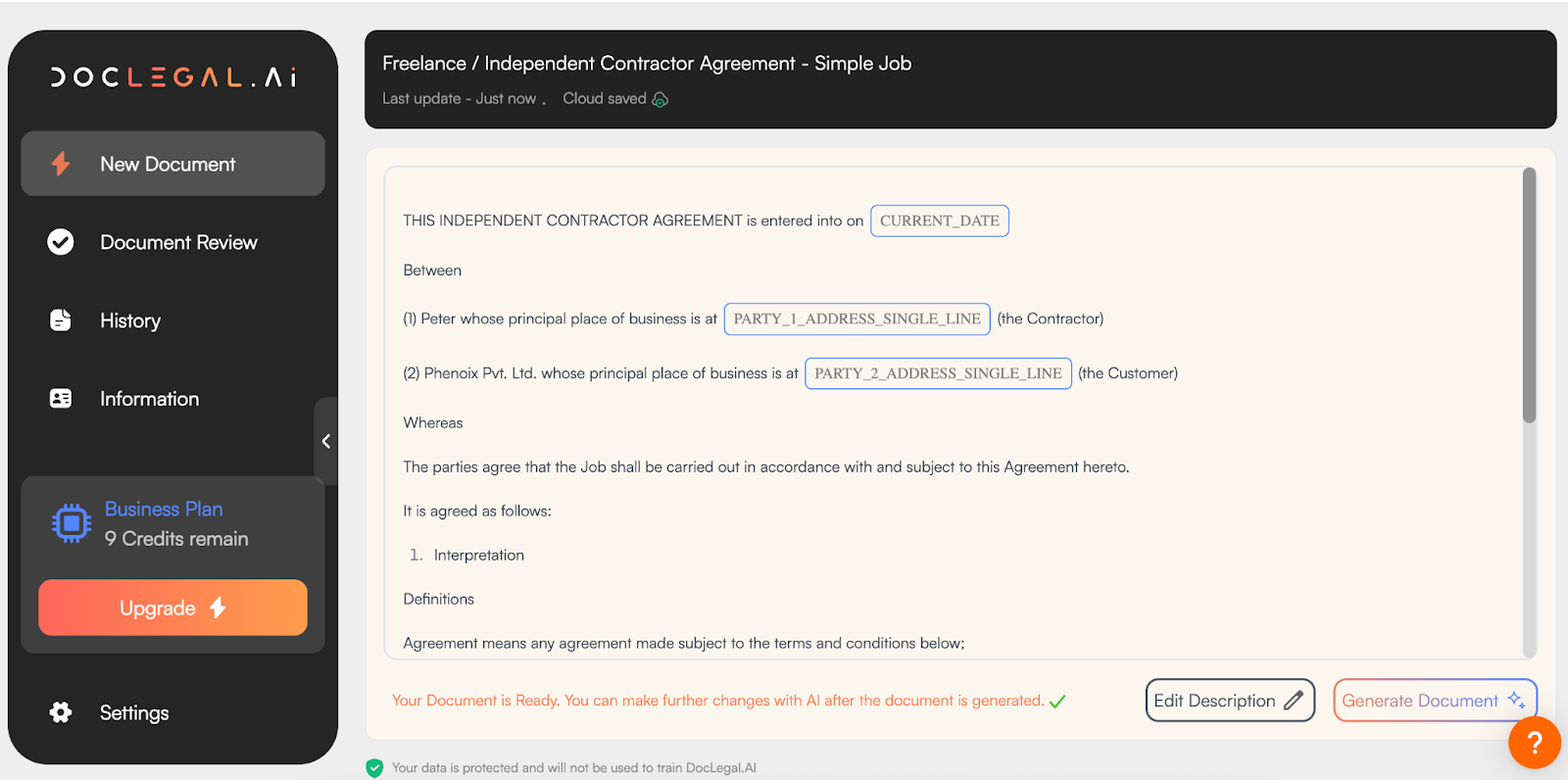How to Draft Freelancer Contracts for Gig Economy Workers
The gig economy is booming, but with freedom comes the risks. Whether you are designing social media content, writing copy, or developing websites. As a one-man band you are designing social media content, writing copy, or developing websites. All these tasks are being done without a full legal team’s support. Hence, a well-crafted freelancer contract can be your safety net. A lawyer approved freelancer contract will offer you legal protection without the scary lawyer fees. In this guide, we’ll walk you through how to prepare a comprehensive freelancer contract.
Why Freelancers Need Freelancer Contracts
Imagine this: You just landed a gig creating logos for a startup on some forum. After countless hours of hard work, you send over your work, but then the client ghosts you when it’s time to pay. Or worse, they start using your designs in ways you never agreed to. These gig economy legal issues are all too common, but a solid contract can definitely prevent them.
A freelancer contract isn’t just a formality, it’s a legal tool that sets clear expectations for both you and your client. It outlines what you’ll do, when they’ll pay, and who owns the work. If you are a young entrepreneur or someone who has just started their side hustle, creating contracts with AI tools like DocLegal.AI ensures your contracts are professional, legally enforceable, and tailored to your needs, without the hefty price tag of a lawyer.
What contracts do you need?
Here are the most commonly used freelancer contracts on our platform:
- For writing-related roles, e.g., copywriting, blog & article writing, email marketing, social media content, academic writing, etc, our Freelance Writer Agreement is tailored to meet your needs.
- For creative and technical professionals, such as web designers or software developers, we recommend the Web Designing Agreement or the Software Development Agreement to define project scope and deliverables.
- After you have delivered your work, use our Freelance Invoice to bill clients clearly and professionally.
- Want to be more flexible? Try our Independent Contractor Agreement and customise it with just a few prompts to suit any freelance arrangement.
Key Elements of a Freelancer Contract
Let’s dive into the essential components of a freelancer contract. These elements protect your work, define responsibilities, and prevent disputes. DocLegal.AI includes all these at the click of a button, making well-drafted contracts accessible to everyone without prior experience in legal drafting.
1. Scope of Work: Define What You’re Providing
The scope of work is the crux of your contract. It spells out exactly what you’ll provide, so there’s no room for confusion. Be as specific as you can, vague terms often lead to misunderstandings and are a breeding ground for disputes.
- What to include: List deliverables (e.g., “three one-minute Instagram Reels” or “a 1,000-word blog post”), deadlines, and any specific requirements (e.g., file formats or revisions).
- Example: “The contractor shall complete the Job by the Completion Date, delivering three (3) original blog posts of more than 1,000 words each. Topics, keywords, and tone will be determined and approved by the Customer prior to commencement. Each post must be delivered in Word format, include relevant headings and metadata, and be optimised for SEO as per the Customer's content guidelines. The Contractor shall provide up to three rounds of revisions per article within five business days of each draft submission, addressing specific feedback provided by the Customer.”
2. Payment Terms: Get Paid Fully and On Time
Money is a top concern for freelancers, and clear payment terms are non-negotiable. A payment clause should outline how much you’ll be paid, when, and how.
- What to include:
- Total fee or hourly rate.
- Payment schedule (e.g., 50% upfront, 50% upon completion).
- Payment method (e.g., PayPal, bank transfer).
- Late payment penalties (e.g., 5% fee for payments over 30 days late).
- Example: “The Customer shall pay the Agreement Price of USD 200 to the Contractor in two instalments: 50% (USD 100) upon signing this agreement, and 50% (USD 100) upon completion of the Job. Payment shall be made by bank transfer to the account details provided by the Contractor.
The Contractor will invoice the Customer for each instalment. The invoice will include all services performed under this Agreement as well as any expenses, if applicable.
Payment will be due upon receipt of the invoice. A late charge of 5% per month on the outstanding amount will be added to any invoice not paid within 30 days of the invoice date.”
3. Intellectual Property (IP) Rights: Protect Your Creations
As a freelancer, your work is your brand. Intellectual property clauses define ownership rights of your work and how it can be used. This is particularly important for creatives and artists.
- What to include:
- Specify whether you’re transferring ownership of your work or granting a license (e.g., the client can use your work for marketing but can’t resell it).
- Clarify usage rights (e.g., purpose, duration, or specific platforms).
- Optional: include a clause protecting your right to showcase the work in your portfolio.
- Example: “The Designer shall retain all Intellectual Property Rights, including copyright, in any and all works, materials, designs, concepts, and deliverables created in the course of providing the Services under this Agreement.
The Designer hereby grants to the Customer a non-exclusive, non-transferable licence to use the deliverables solely for the purposes expressly set out in this Agreement. The Customer shall not reproduce, modify, adapt, or exploit the deliverables for any other purpose without the prior written consent of the Designer.”
4. Termination Clause: Prepare for the Worst
Sometimes, gigs don’t work out. A termination clause outlines how either party can end the contract and what happens afterwards.
- What to include:
- Conditions for termination (e.g., failure to pay, breach of contract).
- Notice period (e.g., 7 days’ written notice).
- Payment for work completed before termination.
- Example: “Either party may terminate this Agreement by giving the other party not less than seven (7) days' written notice in the event of a material breach of this Agreement by the other party, provided that the breach is not remedied within such notice period.”
5. Confidentiality and Non-Disclosure: Safeguard Sensitive Information
If you’re working with sensitive client information or sharing proprietary ideas, a confidentiality clause is essential for safeguarding both you and your client.
- What to include:
- Define what information is confidential (e.g., client’s marketing plans).
- Specify how long confidentiality lasts (e.g., one year after the project ends).
- Example: “Each party undertakes that it shall not at any time during this Agreement, and for a period of one (1) year after termination or expiry of this Agreement, disclose to any person any confidential information concerning the business, affairs, customers, clients or suppliers of the other party, except as permitted by this clause.”
6. Dispute Resolution: Handle Conflicts Professionally
Disputes happen, but a contract can outline how to resolve them without escalating to costly legal battles.
- What to include:
- Specify a process, like mediation or arbitration, before legal action.
- Indicate which state’s laws apply (if necessary).
- Example: “Any dispute or difference, whether contractual or non-contractual, arising out of or in connection with this contract, including any question regarding its existence, validity or termination, shall be referred to and finally resolved by arbitration under the [Arbitration Rules] in force when the notice of arbitration is received by the other party or parties, which rules are deemed to be incorporated by reference in this clause.”
How DocLegal.AI Simplifies the Process
Drafting a contract from scratch can feel overwhelming, especially if you’re new to the gig economy. That’s where we come in. Our freelance agreement AI takes the guesswork out of creating contracts by:
- Guiding you through customisation: Answer a few guided questions about your project, and the platform generates a tailored contract.

- Avoiding legal traps: Both freelancer-favouring and client-favouring contracts are available. Pick based on your position.
- Review Client Contracts with Doclegal.ai: You can upload the Client Contract on DocLegal.ai and get it AI reviewed, customized and downloaded.

- Saving time and money: Say goodbye to substantial lawyer fees or countless hours researching legal terms.
Tips for Using Contracts Effectively
- Review before signing: Always read the contract carefully to ensure it reflects your true intention. A dispute over a single word is all it takes to start a million-dollar litigation.
- Communicate clearly with clients: Discuss contract terms upfront to avoid surprises.
- Keep records: Store signed contracts securely for reference in case of disputes.
- Update as needed: If your services or rates change, use DocLegal.AI to update your freelancer contract template accordingly.
Get Started with DocLegal.AI Today
Ready to take control of your freelance career? Our freelancer contract template makes it easy to create legally sound agreements in minutes. Whether you’re drafting side hustle contracts for influencer partnerships, design projects, or consulting gigs, we’ve got you covered. Visit us now to generate your first contract and start protecting your freelance business with confidence!

.jpg)



.jpg)

.jpg)